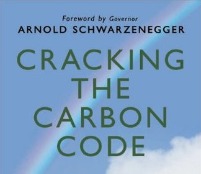 Here it comes — a shameless self-promotion for my new book, Cracking the Carbon Code: The Key to Sustainable Profits in the New Economy. I take the liberty to mention the book, because this blog will give you the key for nothing and, once everyone is doing it, can the movie version be far behind?
Here it comes — a shameless self-promotion for my new book, Cracking the Carbon Code: The Key to Sustainable Profits in the New Economy. I take the liberty to mention the book, because this blog will give you the key for nothing and, once everyone is doing it, can the movie version be far behind?
The Carbon Code is a way to measure the efficiency of your business and show you ways to save money and get ahead of otherwise costly regulations. By measuring your company’s carbon footprint (and it’s not that hard to do) you uncover embedded energy and pollution costs, which once reduced, save big money. Some of those carbon reductions will earn credits under an expanding universe of state and federal regulation and can be sold to your competitors who weren’t smart enough to do the same thing.
Take Cisco Systems, for example. John Chambers, the chairman and CEO, came to visit Gov. Arnold Schwarzenegger in 2005 and surprised us by saying his company was already beginning to measure and report Cisco’s carbon footprint. “Why would Cisco [do that] publicly report carbon emissions when no regulator has asked you to do that?” Schwarzenegger asked Chambers, as we sat around the massive oak conference table in the Reagan Cabinet Room in Sacramento.
“As a high-tech company, we feel obliged to be ahead of the game, especially when we can use new information technology to do it,” Chambers said proudly. “And we save money by doing it. We’ll save over a million dollars this year on energy costs by reducing our carbon footprint — something we might not have done had we not been measuring.”
Measuring carbon helped Cisco discover that 80 percent of the company’s direct energy bills were paid to cool the computers and servers in 50 office buildings and research labs. This motivated Cisco engineers to redesign its products to produce less heat, saving money on energy used to power the devices and on the air conditioning of the rooms in which they were operating. This in turn led the way to new Cisco products that were more valuable to its customers. Cisco also discovered the financial benefits of using state and federal incentives to get nearly 10 percent of its energy from solar and other renewables, shrinking its carbon footprint even more.
Finally, when Chambers decided to take responsibility for the carbon embedded in things such as employee air travel, he not only found another way to cut both cost and carbon, but realized there was growing demand for yet another new product that would help Cisco’s clients. The videoconferencing technology “Telepresence” was born and has since grown to be a significant revenue source for the company. By jumping into the measuring game early, Cisco was able to reduce its own carbon footprint, save money, and improve its products. It also helped the company to stake out valuable territory — by accepting responsibility for no more than will likely be necessary under future carbon regulations.
With a strategy like this that can improve any company’s bottom line, who wouldn’t want to crack the Carbon Code and apply its lessons? Of course the book sets forth the step-by-step and explains concepts like timing a “carbon tipping point,” the Law of Carbon Gravity, and estimating “carbon resilience,” but just by reading this blog you have taken the first basic steps.
Now the only question is who will play me in the movie? And who will play Governor Schwarzenegger for that matter? OK, so some mysteries are better left unsolved.



